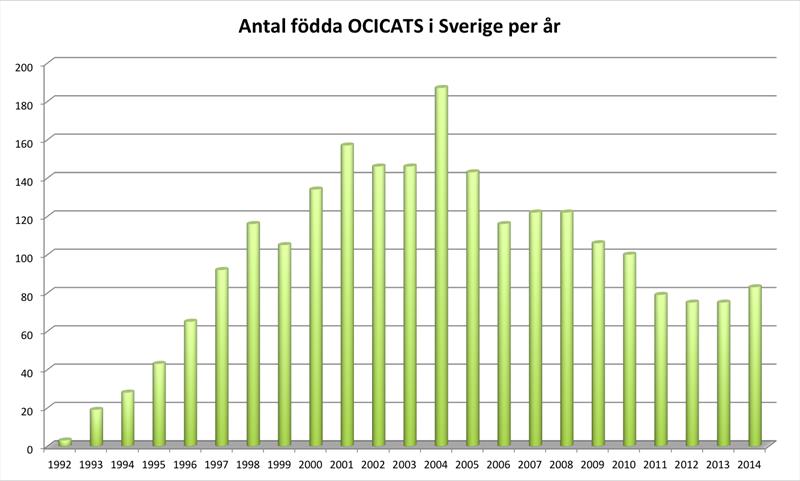What is the Ocicat like?

Tawny spotted Ocicat female, SE*Alsmarks Dajkah. Photo: Madelene Jonsson 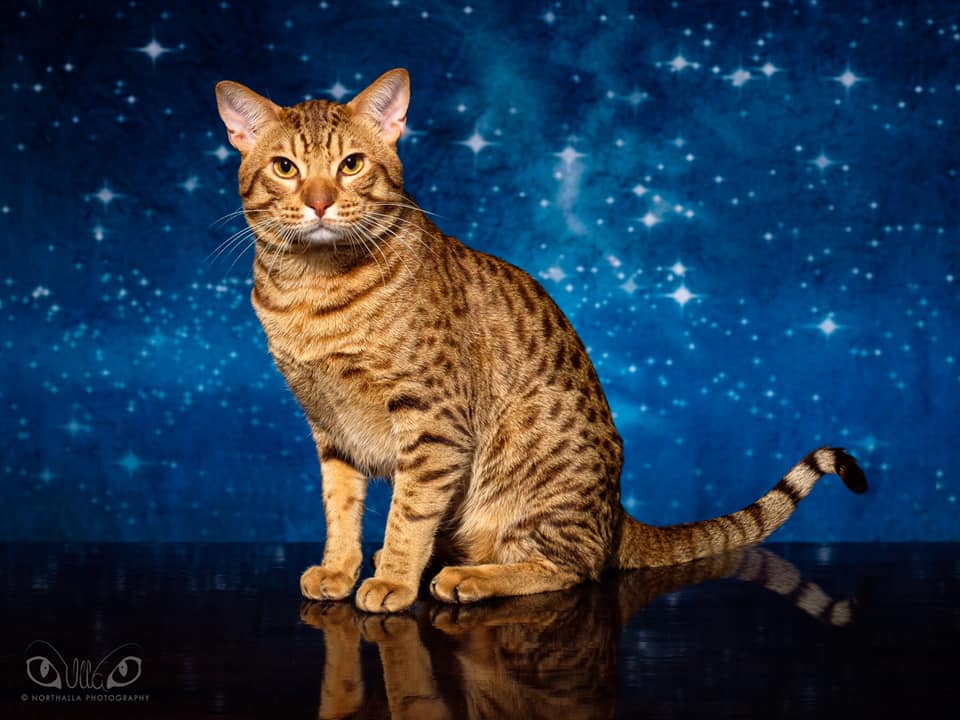
Chocolate spotted Ocicat male. FI*Moosegrove Romeo JR. Photo: Northalla Visuals 
Lavender spotted Ocicat male, NO*Bakste Pus Darwin. Photo: Felida Foto 
Ebony silver spotted female Ocicat, SE*Singers Star Girl. Photo: Madelene Jonsson 
An Ocicat at cat show, being judged. 
Cinnamon spotted Ocicat kitten, FI*Vinkeä Kaneli-Taneli
Ocicat’s character
Ocicats are active, intelligent, and very social cats. They are playful and ideal for families with children, as long as parents will see over and teach the children to behave with cats. Many Ocicats appreciate a feline companion, especially one that has equally active and playful character. Ideally another Ocicat!
Ocicats are communicative – they answer when they are asked something, and they will let you know when they want your attention. Many Ocicats have a characteristic nasal or even a bit creaky meowing sound, not as loud as some other breeds, but some individuals are quite vocal – some others not that much. Many Ocicats are also quite affectionate; some are lap cats while some others prefer to place themselves nearby; most want to hang out with their human companions all the time.
They are very playful and if they don’t have enough activation, it can actually be stressful for them, or they might find an un-wanted way to activate themselves, such as making confetti out of the toilet paper roll. It’s good to understand that Ocicats are not just decorative elements in a home, they are family members with their own needs.
If you are interested, check our this scientific publication by Milla Salonen et. al. about cat breeds and differences of heritable behaviour traits: https://www.nature.com/articles/s41598-019-44324-x Ocicats are studied in this article as a group together with Abyssinian and Somali cats.
Ocicat colors
There are 12 accepted Ocicat colors in FIFe. The only accepted pattern in spotted tabby. All Ocicat colors are caused by eumelanin granules in hair shafts. The “wild type” eumelanin produces black color, and there are also two variations of the gene B that dictates the eumelanin type. Variation b gives hairs a lighter shade that is brownish, and variation bl even lighter, reddish-toned color. The genotype of the cat defines the color as follows:
- Black (B -)
- Chocolate (b b, or b bl)
- Cinnamon (bl bl)
If the cat inherits the wild type gene B from one or both parents, the color of the fur will be black. Actually, the tabby pattern lightens how we see the color: the overall look of the spotted tabby cat that has black B gene is tawny/brown. The spots are dark brown to black and the underlying color is light brown. The gene B dominates over chocolate and cinnamon.
If the cat has inherited chocolate variation of the gene (b) from both its parents (or chocolate from one and cinnamon bl from another parent), the color of the cat is chocolate brown. The spotted tabby pattern again causes the chocolate color to be intensive on the pattern, and the underlying color is light brown, s bit warmer than on the tawny/black spotted cat.
A cat can only display cinnamon color if it has inherited the cinnamon variant of the gene from both parents (genotype bl bl). The color of the pattern is then cinnamon brown and the underlying color is very warm shade of light brown.
The dilution gene is responsible for color variations of blue, lavender, and fawn. The dilution gene is independent from the eumelanin gene variation. The dilution gene is recessive, so the cat needs to get one allele from both parents to show dilute color. With dilution, the black becomes blue, chocolate becomes lavender, and cinnamon becomes fawn. Now we understand six of the twelve Ocicat colors.
Then the silvers. A dominant (needs to be inherited from only one parent) inhibitor gene is responsible for making the base color white instead of light brown. The color of the pattern is a bit darker than it would appear without inhibitor gene. Inhibitor gene is inherited independently from eumelanin and dilution. With inhibitor gene, tawny spotted becomes (black) silver spotted, chocolate spotted becomes chocolate silver spotted, etc. Dilution silver spotted cats can sometimes be tricky to distinguish from dilution spotted.
In FIFe registers, the colors and patterns are marked with EMS codes (Easy Mind System). The relevant EMS codes for ocicats are:
- OCI, means the Ocicat breed
- n, black
- b, chocolate
- o, cinnamon
- a, blue
- c, lavender
- p, beige/fawn
- s, silver/smoke
- 24, spotted tabby
- 22, blotched tabby
- 25, ticked tabby
Examples:
- OCI n 24 = Ocicat, tawny (black) spotted tabby
- OCI os 24 = Ocicat, cinnamon silver spotted tabby
- OCI x c 22 = Ocicat, lavender blotched tabby (see below)
It can happen that sometimes two spotted tabby parents have kittens with blotched tabby pattern, or solid color (without pattern, except faint ghost pattern). When introducing more genetic material into Ocicats’ gene pool, Ocicats can be crossed with Abyssinians and the resulting kittens can have ticked pattern, resembling more Abyssinian than Ocicat. Ocicats with patterns other than spotted tabby, are marked in FIFe EMS codes with x, e.g. OCI x bs 22 (chocolate silver blotched tabby).
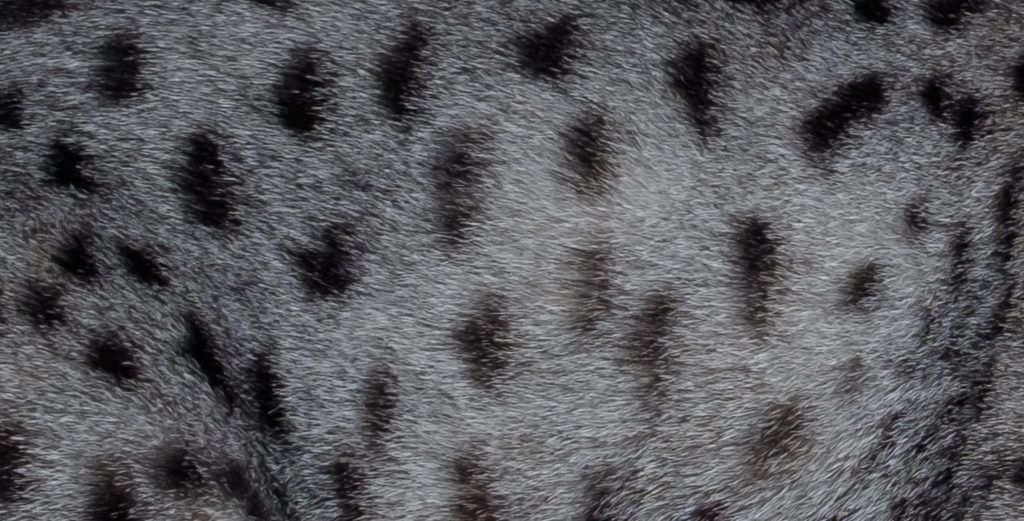
Ocicat breed standard
| General | Ocicat is medium to large, well-spotted agouti cat of moderate type. It displays the look of an athletic animal; well muscled and solid, graceful and lithe, yet with a fullness of body and chest. It is alert to its surroundings and shows great vitality. This powerful, athletic, yet graceful, spotted cat is particulary noted for its wild appearance. |
| Head | The skull is a modified wedge showing a slight curve from the muzzle to the cheeks, with a visible, but gentle ris from the bridge of the nose to the brows. The muzzle is broad and well defined with a suggestion of squareness and in profile shows good length. The chin is strong with a firm jaw with a proper bite. The whisker pads: moderate, whisker pinch is not too severe. |
| Ears | Alert, moderately large. When present, ear tufts extending vertically from the tips of the ears are a bonus. Placement: set so as to corner the upper, outside dimensions of the head. If an imaginary horizontal line is drawn across the brow the ears should be set at 45 degrees angle, i.e. neither too high not too low. |
| Eyes | Large, almond in shape, and angled slightly upwards towards the ears, with more than the length of an eye between the eyes. All eye colors except blue are allowed. There is no correspondence between eye color and coat color. Intensive color is preferred. |
| Neck | The head is carried gracefully on an arched neck. |
| Body | Rather long-bodied, solid, with depth and fullness but never coarse. Substantial bone and muscle development, yet with an athletic appearance. There should be some depth of chest with ribs slightly sprung. The back is level to slightly higher on the rear, and the flanks are reasonably level. |
| Legs | Medium long, of good substance and well muscled; powerful and in good proportion to the body. Paws: Oval and compact, with size in proportion to the legs. |
| Tail | Fairly long, medium slim with only a slight taper and with a dark tip. |
| Coat | Short, smooth and satiny in texture with a lustrous sheen; tight, close lying and sleek, yet long enough to accomodate the necessary bands of color. There should be no suggestion of woolliness and length. All colors should be clear and pleasing. The lightest color is usually found on the face around the eyes, on the chin and lower jaw. The darkest color is found on the tip of the tail. To determine the correct coat color, the color of the tail tip is decisive. |
History of the Ocicat
Text by: Jessica Lundgren
Ocicat is an exotic, spotted cat that is known for its dog-like affection she shows to her human companion, and still looks like a jungle cat.
The popularity of Ocicat has been extraordinary; today Ocicats have set their paws in most countries around the world.
The first Ocicat was born in 1964 by a lucky mistake. A lade called Virginia Daly, the breeder of “Dalai”, wanted to produce a Siamese cat with Abyssinian ticked mask in the 1960’s. Her plan was to mate an Abyssinian with a Siamese, and then mate the offspring back on a Siamese.
In the 50’s and 60’s the experimental breeding was more accepted than today. Other experimental programs Mrs. Daly did were Siamese & Tabby domestic cat / Siamese hybrid, which produced a pair of lynx point Siamese. A cross between a Siamese & Calico domestic cat / Siamese hybrid resulted in pinto Siamese, and a Havana brown & lavender masked Siamese resulted in lavender.
The results of Mrs. Daly’s experimental breeding in 1950 produced ACFA’s first flame point Siamese female to the Grand Champion, and by crossing a red Persian with a Siamese; the ancestor of the first American colorpoint Persians. Later she got GRC Dalai Jakki – USA’s best seal point Siamese 5 years in a row.
But her greatest joy was to breed with the hybrids. (hybrid = offspring of two different breeds) – often repetitions of other breeders’ mistakes. She developed a rather unique insight into how she got the best quality of these different cats and she did not realize that just such a mating would result in a completely new breed; the Ocicat.
The original line from the Dalai Ocicats began with the offspring of an imported Abyssinian champion named Raby Chuffa of Selene. It is believed that it was this male who gave the cinnamon gene (then called golden), to his son Dalai Deta Tim of Selene, a ruddy aby. Chuffa is also behind many Somali lines (somali = semi-long-haired Abyssinians), but fortunately the ocicat has not got that semi-long-haired disposition – despite a lot of line breeding with this line.
A ruddy aby was chosen because, ironically, there were a few, if any, red abys in the United States at that time to work with in any breeding program. Tim was paired with a sealpoint siamese hona, resulting in Dalai Tomboy Patter. Patter was a large and powerful Siamese, even for the 60’s standard. The whole litter looked and was phenotypically Abyssinian.
The only female Mrs. Daly kept was Dalai She, a ruddy aby hybrid. Dalai She was paired with CH Whitehead Elegante Sun, called “Sunny”, a chocolate masked Siamese who himself was after an imported chocolate masked Siamese CH Kanhuri Hassan. Sunny was a large and well-muscled cat with a dark color. In the litter after Dalai She & Sunny was the long-awaited aby-masked Siamese, along with mackerel tabbys, a lynxpoint, a black, a classic tabby – and a gift from nature.
This “ugly duckling” was a beautiful cinnamon-spotted male, later christened Tonga. Mrs. Daly’s daughter (also called Virginia) thought Tonga looked like an ocelot and asked if they could call him Ocicat.
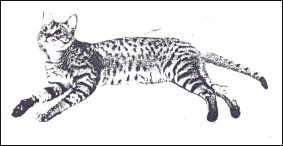
This litter born on a frosty morning in 1964 in Michigan is the true start of the history of the Ocicat. The beginning could also be the end. Tonga was sold as a company tax with a castration agreement to a medical student, Thomas Brown, for $ 10. Tonga was first exhibited February 20-21, 1965 in Detroit as a special novelty. There were 16 cats that were exhibited as special novices, and in the catalog it was stated that these were the breeds of the future. So right they were.
Daly later came in contact with the well-known geneticist Dr. Clyde Keeler at the University of Georgia who was interested in breeders who wanted to produce a cat similar to the extinct Egyptian spotted fishing cat. Clyde suggested that Tonga mate his mother Dalai She. This mating never happened. But Daly’s interest had been aroused in producing ocicats, and that became her personal goal.
Although Tonga himself was never in the breeding program, the mating between Dalai She and Sunny, who produced Dalai Dotson, a brown-spotted male that Virginia used as a breeding male, was repeated. Dotson was registered in the CFA as Ocicat and other breeders thus saw the recipe (F2 Aby x Siamese) and went a step further by introducing American shorthair, for its substance and its silver gene.
Cats worth mentioning here were Serendip Silver Olivia (American Shorthair x Siamese) and Dalai Maha Gony (American Shorthair x Abyssinians). Other interested breeders such as Barbara Rounds “Darwin”, Rita Marcuse “Aruby”, Dr H.E. & Beula Viergutz “Jobeuca” was among the first to work with the ocica painting.
The collaboration produced Darwin Vierdalai of Dalai who received the Dalai Golden Phoenix “Nikki” and Dalai Sequin, whose offspring include GRC Dalai Golden Cavalier of Ociville, -CFA’s first ocicat Grand Champion and which is found in most pedigrees today.
Mrs. Daly put her breeding program aside when her aunt became ill, and between 1966 and 1980, a total of only 99 were registered. Ocicats International started in 1984 with 22 members. Under the leadership of Virginia Daly, Bill Mc Kee, Ann Hollier, Kaye Chambers and Alana DeBruhl, the breed was approved in the United States in 1988.
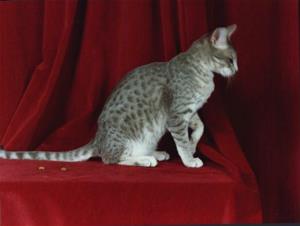
The first Ocicat in Sweden’s (and Scandinavia) came to Gothenburg from England in December 1991: CH Lotsadots Chunky Blue, a blue-spotted male, and in January 1992, Thickthorn Rosemary from England, a black-silver-spotted female. The couple was imported by Jessica Lundgren and they premiered at Boråskatten’s show in April 1992. They did not participate in the competition, as they were still not approved as a breed in FIFe, but they attracted a lot of attention from audiences, exhibitors and the press.
Additional imports from England came in 1992: Lotsadots Blue Angel, a blue-spotted female, GIC Thickthorn Bryony, a brown-spotted female, C Thickthorn Chicory, a brown-spotted male and Thickthorn Polka Dot, a brown-spotted female.
920601, the Ocicat was approved as a breed in FIFe.
921015 Sweden’s first litter of ocicats was born: CH Halifax Hux Flux, CH Halifax Dainty Daisy, and EC Halifax Cheery Chap; -which was Sweden’s first ocicat to become Best in Show and to receive the title European Champion.
Statistics
In 1993, 18 ocicats were registered in Sweden and Norway’s first 3 ocicats were imported from Sweden: IC Halifax Hot Shot, Halifax Dina Isabella and GIC Halifax Mixie. In 1993, family Stenroos imported Finland’s first ocicats EC Gemlou Pink Panther, a purple-spotted male, and Gemlou First Lady-of-Galax, a cinnamon-spotted female from Texas, USA, and started breeding Ocicats in Finland.
In 1994, 29 ocicats were registered in Sweden and 5 in Norway.
In 1995, 54 ocicats were registered in Sweden, of which 8 were imports. In Norway 10 were registered, and in Finland 35.
